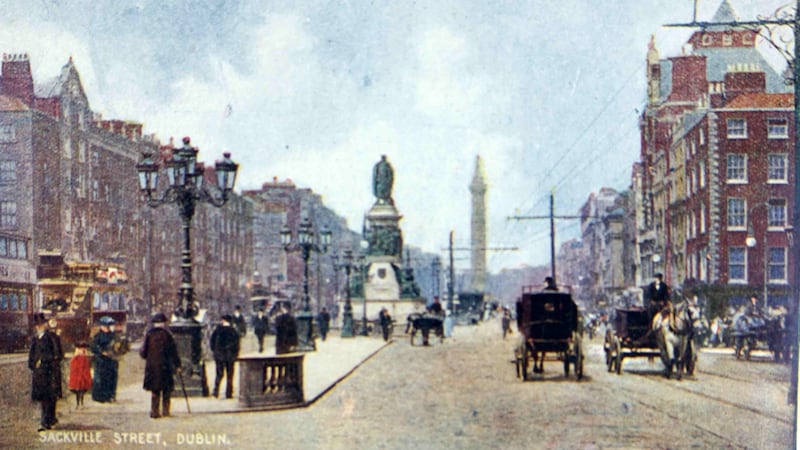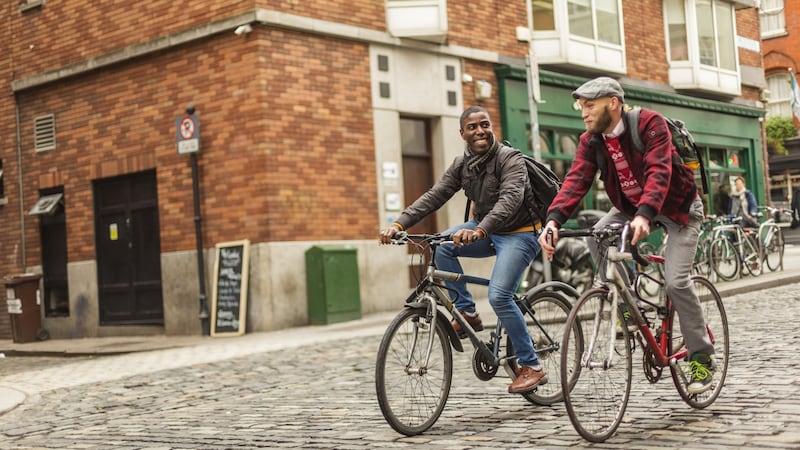The pandemic is a harsh searchlight. It doesn’t just change things – it reveals them. And among the things it has exposed most starkly is the terrible lack of a long-term vision for one of Ireland’s great treasures – the city centre of Dublin.
The coronavirus will speed up changes that have been under way for at least a decade. More people will work from home, so what will become of the office blocks?
More shopping has moved online, so what will happen to the big retailers on whom the life of the city centre depends? Will the endless construction of more hotels make sense in a world where tourism and travel have to be rethought?
If, as they say they will, planners now seek to develop “urban villages” around the outer city, where people will live, work and shop within their own area, what happens to the old heart of the 18th century city? What happens to the old habit of “going into town”?
There are two very different answers to these questions. The Georgian core of the city can become a ghost town dotted with a few grand Government buildings and prestige cultural institutions and hotels. Or it can be reimagined and reoccupied as a living and lively public space.
This choice is political. It is a matter of collective will. But, to put it plainly, there has never been a political will to take ownership of the city centre on behalf of the citizens whose capital it is supposed to be.
Consider July 25th 2019. Two things happened on the same day. One was that the entire cabinet met to consider the awarding of the 2026 Ryder Cup golf tournament to Adare Manor in Co Limerick.
The then Taoiseach Leo Varadkar, hailing the prospect of “a fantastic occasion for everyone on the island of Ireland”, committed the State to whatever amount of money might be needed to make this happen. The widely quoted figure was €50 million, but since there was no official estimate, it could be much more.
This is what political engagement looks like. The Ryder Cup matters to the political class. Dublin city doesn’t.

That same evening, Dublin City Council met and was informed by the city manager, Owen Keegan, that plans to redevelop Parnell Square as a cultural quarter, a project that has been in train since 2005, had collapsed.
Just three months earlier, the council had received the green light from An Bord Pleanála for the project, which included a new city library, a 200-seat conference centre, a music centre, education facilities, a multicultural space and a café and exhibition space, spanning the north side of the square.
It would create a new public plaza, and restore some of the city’s finest Georgian houses,including the former Coláiste Mhuire school and two other Georgian houses immediately west of the Hugh Lane Gallery. It would act as a catalyst for the redevelopment of the entire north inner city of Dublin.
It would also, incidentally, highlight the worldwide standing of its brilliant architects, Yvonne Farrell and Shelley McNamara, who last year won the architectural equivalent of the Nobel Prize, the Pritzker.
Grand project
When An Bord Pleanála had approved the scheme, the then lord mayor of Dublin Nial Ring hailed the news as "brilliant": "This part of the north inner city will eventually be a cultural, social and economic hub. The whole area will be transformed with the completion of this new city cultural quarter."
Amid the celebrations, there might have been reason to be sceptical. The lord mayor added: “The fact that it is being part-funded by philanthropy is an exciting, new and innovative way of giving life to this neglected part of town.”
Philanthropy? Indeed. The grand project was built on the sands of charity. The funding model – shameful and ludicrous in equal measure – was that 55 per cent of the entire cost would be raised from private charitable donors.
This vital plan for the regeneration of the centre of Ireland’s capital was predicated on the belief that something called the Parnell Square Foundation would raise 55 per cent of the funding from super-rich donors. It turned out, predictably, that Ireland’s super-rich were not interested. So the library is going ahead and everything else – the whole scheme for a cultural quarter – was deferred to “a later stage”.
Nothing could better illustrate the pathetic state of official thinking about the city centre. Shiny new pet projects, like a whitewater-rafting facility on George’s Dock, suck up public money. It was supposed to cost €12 million; then it was €23 million; last week it was €25 million and counting. But the chipped jewel that is the Georgian city has to hope for some non-existent charitable benefactors to drop out of the sky.
There’s a deep history here. Dublin is a city with abandonment issues.
Georgian Dublin, whose streetscape we inherited, was a city of European importance. In 1750, it was the fifth largest city north of the Alps – bigger than Madrid or Berlin, about the same size as Milan, a little smaller than Lisbon. Of Europe’s ten biggest cities, it was the only one that was not the capital of a sovereign state.
This, of course, was its downfall. After the Act of Union, there was what David Dickson in his masterly history, Dublin: The Making of a Capital City, calls “a hollowing out of the city’s manufacturing economy”. The impoverishment and deskilling of much of its working class was paralleled by the withdrawal of much of its gentry – a double process that came together in the infamous tenements, once grand town houses, now teeming slums.
The old city has never really lost this sense of abandonment. The main concern of Irish governments after the foundation of the State was to move people out of it, through the process of slum clearance.
From the 1960s onwards, this had the very pleasant side-effect for a small elite of developers of opening the inner city for lucrative office blocks. Two hundred of them were built between 1960 and 1985. As Dickson puts it: “It was a small world, it was a new game, the regulatory culture was weak , and rules were certainly bent.”
The inner city was treated, therefore, either as a place to be forsaken or a resource to be ruthlessly exploited. It was never to be loved, lived in, possessed as a common heritage.
Brutal reality
Even when the State got heavily involved in reshaping the inner city, it did so ultimately on behalf of commercial interests. The 27 acres of the old Custom House Dock, a grand publicly-owned site right at the heart of the old city, could have been redeveloped as a vibrant new quarter on the Liffey, but became instead the sterile Financial Services Centre.
Temple Bar, with its pre-Georgian 17th century streetscape, was saved by Charles Haughey from CIE's plans to demolish it to make way for a giant bus station. But it too became a place where fortunes were made, in this case by developers, hoteliers and super-publicans.
This has been the brutal reality: unless there’s a fortune to be made for somebody, the inner city doesn’t matter. This is a city, after all, that allowed its own literal foundations at Wood Quay to be squatted on by the massive concrete bunkers of Sam Stephenson’s glowering Civic Offices, the headquarters of the city’s government that looks much more like the command centre of an invading regime.

What’s evolved in recent decades has been nothing more than an uneasy stand-off. There is just about enough appreciation for the inner city to stop the worst of the depredations of the 1960s and 1970s. But there is not enough to really take it back as a public space.
The pandemic, in speeding up processes that were already underway, has made the continuation of this stand-off impossible.
Without a radical vision for its future, the old city is facing its third great abandonment. The first was the departure of wealth and industry from the Georgian city in the 19th century. The second was the removal of much of the working-class population to the new housing estates in the 20th century. The third will be the dwindling of the office-and-retail city in the 21st century.
It should also be borne in mind that maternity hospitals – an important part of the fabric of the inner city’s social and working life – are also moving out. The Rotunda will move to Blanchardstown; Holles Street to the St Vincent’s campus.
But there is also a historic opportunity to reinvigorate central Dublin. To grasp it, we have to begin with the most basic question: to whom should this place belong?
If the answer is, as it has been for so long, only to the people who can make fortunes out of it, the inner city is in possibly terminal trouble.
But there are other people who would be only too happy to occupy what is still, in spite of all the assaults it has endured, a beautiful place. There are people who want to live in it. There are small businesses that could thrive in it. And there are artists and cultural institutions that could restore its battered reputation as a global centre of creativity.
Depending on how it is defined, the city centre houses about 116,000 people. That’s actually fewer than it contained in 1750. The paradox is that some of the most beautiful residential real estate in Europe has almost no actual residents.
Cultural life
A study seven years ago found that only three houses on Merrion Square and eight houses on Fitzwilliam Square were actually lived in. Even that understated the scale of desertion, since some of these houses were only partially occupied.
Secondly, small shops have been largely driven out of the urban core by high rents and replaced by large retail chains that make much of inner Dublin look indistinguishable from any provincial English city.
Thirdly, the artistic and cultural life that is so crucial to the attractiveness of the centre city has been poorly served. On the one hand, long-mooted infrastructural projects, like the redevelopment of the Abbey Theatre, have repeatedly stalled. On the other, the informal infrastructure of small, cheap spaces has been squeezed relentlessly by commercial development.
What all this means, though, is that there is a great deal of warm blood that is ready to be infused into the old city.
The issue is not that 21st century Irish society has no use for this great relic of the Ascendancy. It is that the city has become increasingly unavailable for those uses. The trick, of course, is to make it accessible to those who want it.
This is not going to be done by market forces. In fact, it will require some very strong interventions to bring down the unsustainable rents that are making the city uninhabitable for so many people.
Nor, as the experience of the Parnell Square project shows, is it likely to be achieved by the City Council acting on its own.
What the city centre needs is a powerful and independent body that brings together local and national government, the Land Development Agency, the Housing Agency, the cultural sector and some of the brilliant architects that Dublin is currently blessed with. Above all, it needs ambitious and visionary leadership.
If it gets it, Dublin will not be, as the song claims, heaven. But it will be something rather better – one of the more liveable and likeable urban spaces on Earth.

















